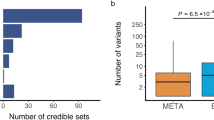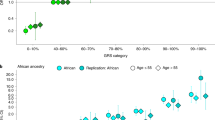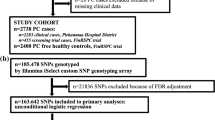Abstract
Androgens are of primary importance in the etiology of prostate cancer, and binding of the androgen dihydrotestosterone to the androgen receptor is thought to stimulate prostate growth. It has been proposed that polymorphisms within key androgen regulatory genes may contribute to an individual's risk of developing prostate cancer. Attributing single polymorphisms to complex, late-onset, chronic diseases such as prostate cancer is probably not feasible, but identification of genes that increase risk will contribute to larger-scale multigenic risk assessment. Here, we review the current status of our knowledge of associations between important androgen regulatory gene polymorphisms and prostate cancer risk.
This is a preview of subscription content, access via your institution
Access options
Subscribe to this journal
Receive 12 print issues and online access
$209.00 per year
only $17.42 per issue
Buy this article
- Purchase on Springer Link
- Instant access to full article PDF
Prices may be subject to local taxes which are calculated during checkout


Similar content being viewed by others
References
Jemal A et al. (2004) Cancer statistics, 2004. CA Cancer J Clin 54: 8–29
Gelmann EP (2002) Molecular biology of the androgen receptor. J Clin Oncol 20: 3001–3015
Irvine RA et al. (1995) The CAG and GGC microsatellites of the androgen receptor gene are in linkage disequilibrium in men with prostate cancer. Cancer Res 55: 1937–1940
Mhatre AN et al. (1993) Reduced transcriptional regulatory competence of the androgen receptor in X-linked spinal and bulbar muscular atrophy. Nat Genet 5: 184–188; erratum Nat Genet 6: 214
Chamberlain NL et al. (1994) The length and location of CAG trinucleotide repeats in the androgen receptor N-terminal domain affect transactivation function. Nucleic Acids Res 22: 3181–3186
Novelli G et al. (2004) Pharmacogenetics of human androgens and prostate cancer—an update. Pharmacogenomics 5: 283–294
Koivisto P et al. (1997) Androgen receptor gene amplification: a possible molecular mechanism for androgen deprivation therapy failure in prostate cancer. Cancer Res 57: 314–319
Marcelli M et al. (2000) Androgen receptor mutations in prostate cancer. Cancer Res 60: 944–949
Taplin ME et al. (2003) Androgen receptor mutations in androgen-independent prostate cancer: Cancer and Leukemia Group B Study 9663. J Clin Oncol 21: 2673–2678
Gottlieb B et al. (2004) The androgen receptor gene mutations database (ARDB): 2004 update. Hum Mutat 23: 527–533; erratum Hum Mutat 24: 102
Montgomery JS et al. (2001) The androgen receptor gene and its influence on the development and progression of prostate cancer. J Pathol 195: 138–146
Mononen N et al. (2000) Two percent of Finnish prostate cancer patients have a germ-line mutation in the hormone-binding domain of the androgen receptor gene. Cancer Res 60: 6479–6481
Gruber SB et al. (2003) R726L androgen receptor mutation is uncommon in prostate cancer families in the United States. Prostate 54: 306–309
Ross RK et al. (1998) Androgen metabolism and prostate cancer: establishing a model of genetic susceptibility. Cancer Res 58: 4497–4504
Taplin ME et al. (1995) Mutation of the androgen-receptor gene in metastatic androgen-independent prostate cancer. N Engl J Med 332: 1393–1398
Taplin ME et al. (1999) Selection for androgen receptor mutations in prostate cancers treated with androgen antagonist. Cancer Res 59: 2511–2515
Feldman BJ and Feldman D (2001) The development of androgen-independent prostate cancer. Nat Rev Cancer 1: 34–45
James AJ et al. (2002) A novel androgen receptor mutant, A748T, exhibits hormone concentration-dependent defects in nuclear accumulation and activity despite normal hormone-binding affinity. Mol Endocrinol 16: 2692–2705
Matias PM et al. (2000) Structural evidence for ligand specificity in the binding domain of the human androgen receptor. Implications for pathogenic gene mutations. J Biol Chem 275: 26164–26171
Ntais C et al. (2003) Association of the CYP17 gene polymorphism with the risk of prostate cancer: a meta-analysis. Cancer Epidemiol Biomarkers Prev 12: 120–126
Habuchi T et al. (2000) Increased risk of prostate cancer and benign prostatic hyperplasia associated with a CYP17 gene polymorphism with a gene dosage effect. Cancer Res 60: 5710–5713
Wadelius M et al. (1999) Prostate cancer associated with CYP17 genotype. Pharmacogenetics 9: 635–639
Latil AG et al. (2001) Prostate carcinoma risk and allelic variants of genes involved in androgen biosynthesis and metabolism pathways. Cancer 92: 1130–1137
Madigan MP et al. (2003) CYP17 polymorphisms in relation to risks of prostate cancer and benign prostatic hyperplasia: a population-based study in China. Int J Cancer 107: 271–275
Chang BL et al. (2003) Polymorphisms in the CYP1B1 gene are associated with increased risk of prostate cancer. Br J Cancer 89: 1524–1529
Ntais C et al. (2003) SRD5A2 gene polymorphisms and the risk of prostate cancer: a meta-analysis. Cancer Epidemiol Biomarkers Prev 12: 618–624
Shimada T et al. (1999) Catalytic properties of polymorphic human cytochrome P450 1B1 variants. Carcinogenesis 20: 1607–1613
Tang YM et al. (2000) Human CYP1B1 Leu432Val gene polymorphism: ethnic distribution in African-Americans, Caucasians and Chinese; oestradiol hydroxylase activity; and distribution in prostate cancer cases and controls. Pharmacogenetics 10: 761–766
Tanaka Y et al. (2002) Polymorphisms of the CYP1B1 gene have higher risk for prostate cancer. Biochem Biophys Res Commun 296: 820–826
Waxman DJ et al. (1988) Human liver microsomal steroid metabolism: identification of the major microsomal steroid hormone 6 beta-hydroxylase cytochrome P-450 enzyme. Arch Biochem Biophys 263: 424–436
Kleinbloesem CH et al. (1984) Variability in nifedipine pharmacokinetics and dynamics: a new oxidation polymorphism in man. Biochem Pharmacol 33: 3721–3724
Rebbeck TR et al. (1998) Modification of clinical presentation of prostate tumors by a novel genetic variant in CYP3A4. J Natl Cancer Inst 90: 1225–1229; erratum J Natl Cancer Inst 91: 1082
Ball SE et al. (1999) Population distribution and effects on drug metabolism of a genetic variant in the 5′ promoter region of CYP3A4. Clin Pharmacol Ther 66: 288–294
Kittles RA et al. (2002) CYP3A4-V and prostate cancer in African Americans: causal or confounding association because of population stratification? Hum Genet 110: 553–560
Zeigler-Johnson C et al. (2004) CYP3A4, CYP3A5, and CYP3A43 genotypes and haplotypes in the etiology and severity of prostate cancer. Cancer Res 64: 8461–8467
Nam RK et al. (2003) Comprehensive assessment of candidate genes and serological markers for the detection of prostate cancer. Cancer Epidemiol Biomarkers Prev 12: 1429–1437
Gsur A et al. (2004) Genetic polymorphisms and prostate cancer risk. World J Urol 21: 414–423
Wojnowski L et al. (2002) Re: modification of clinical presentation of prostate tumors by a novel genetic variant in CYP3A4. J Natl Cancer Inst 94: 630–631; author reply 631–632
Plummer SJ et al. (2003) CYP3A4 and CYP3A5 genotypes, haplotypes, and risk of prostate cancer. Cancer Epidemiol Biomarkers Prev 12: 928–932
Cicek MS et al. (2004) Association of prostate cancer risk and aggressiveness to androgen pathway genes: SRD5A2, CYP17, and the AR. Prostate 59: 69–76
Soderstrom T et al. (2002) 5 alpha-reductase 2 polymorphisms as risk factors in prostate cancer. Pharmacogenetics 12: 307–312
Shibata A et al. (2002) Polymorphisms in the androgen receptor and type II 5 alpha-reductase genes and prostate cancer prognosis. Prostate 52: 269–278
Nam RK et al. (2001) V89L polymorphism of type-2, 5-alpha reductase enzyme gene predicts prostate cancer presence and progression. Urology 57: 199–204
Makridakis NM et al. (1999) Association of mis-sense substitution in SRD5A2 gene with prostate cancer in African-American and Hispanic men in Los Angeles, USA. Lancet 354: 975–978
Mononen N et al. (2001) A missense substitution A49T in the steroid 5-alpha-reductase gene (SRD5A2) is not associated with prostate cancer in Finland. Br J Cancer 84: 1344–1347
Makridakis NM et al. (2000) Biochemical and pharmacogenetic dissection of human steroid 5 alpha-reductase type II. Pharmacogenetics 10: 407–413
Chang BL et al. (2002) Joint effect of HSD3B1 and HSD3B2 genes is associated with hereditary and sporadic prostate cancer susceptibility. Cancer Res 62: 1784–1789
Devgan SA et al. (1997) Genetic variation of 3 beta-hydroxysteroid dehydrogenase type II in three racial/ethnic groups: implications for prostate cancer risk. Prostate 33: 9–12
Rheaume E et al. (1995) Identification and characterization of the G15D mutation found in a male patient with 3 beta-hydroxysteroid dehydrogenase (3 beta-HSD) deficiency: alteration of the putative NAD-binding domain of type II 3 beta-HSD. Biochemistry 34: 2893–2900
Author information
Authors and Affiliations
Corresponding author
Ethics declarations
Competing interests
The authors declare no competing financial interests.
Rights and permissions
About this article
Cite this article
Singh, A., Chau, C., Price, D. et al. Mechanisms of Disease: polymorphisms of androgen regulatory genes in the development of prostate cancer. Nat Rev Urol 2, 101–107 (2005). https://doi.org/10.1038/ncpuro0091
Received:
Accepted:
Issue Date:
DOI: https://doi.org/10.1038/ncpuro0091
This article is cited by
-
Genetic polymorphisms of CYP17A1 in steroidogenesis pathway are associated with risk of progression to castration-resistant prostate cancer in Japanese men receiving androgen deprivation therapy
International Journal of Clinical Oncology (2013)
-
Low serum testosterone levels are predictive of prostate cancer
World Journal of Urology (2013)



